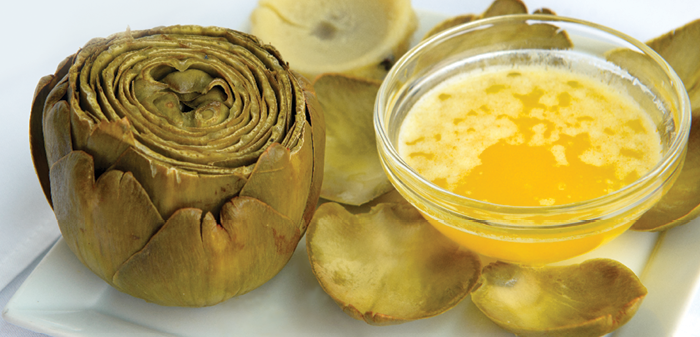
Diet: Gluten-Free, Vegetarian, Paleo, Dairy Free, Vegan
European immigrants brought artichokes to the United States in the nineteenth century, first to Louisiana and later to the coastal regions of northern California, where the cool, foggy climate has proven ideal for their cultivation. More than two-thirds of the domestic artichoke crop is sold fresh, with much of the rest being canned or frozen, usually in the form of artichoke hearts or bottoms.
A single artichoke is actually an unopened flower bud from a thistle-like plant. Each cone-shaped bud consists of several parts: overlapping outer leaves that are tough and inedible at the tip, but fleshy and tender at the base; an inedible choke, or thistle, which is enclosed within a light colored cone of immature leaves; and a round firm-fleshed base. Although this latter part is often referred to as the “heart” of an artichoke, it is more accurately called the bottom.
Artichokes vary greatly in size. Differences are not related to quality or maturity, but are determined by the part of the stalk the buds grow on – the large ones are on the center stalk, smaller ones on side branches, and ‘baby’ artichokes at the base.
Nutritionally speaking, artichokes are low in calories and full of nutrients such as fiber, vitamin C, folate and magnesium. They also contain some of the highest levels of disease-fighting antioxidants among fresh vegetables.
Ingredients
- Artichokes
Directions
-
Wash artichokes under cold, running water.
-
Using a soft kitchen brush or cloth, brush down the artichokes to remove the natural film an artichoke produces while it is growing. This can give the artichoke a bitter taste if not removed.
-
Pull off lower petals and cut off the stem, even with the bottom of the artichoke.
-
Cut about an inch off the top of the artichoke – straight across the top of the petals (a serrated knife works great).
-
Using a pot that is large enough to accommodate the artichokes in a single layer, arrange them in bottom of pot. Add water to a depth of 1 to 2 inches. Bring water to a boil and turn down heat so that the water remains at a low simmer. Cover pot and cook for 25-45 minutes, depending on the size of the artichokes. Check occasionally to be sure the water is not boiling away, and add more if necessary. The test for doneness is to pull out a leaf. If it comes away from the artichoke easily, it’s done.
-
Serve on a plate with a small bowl of melted butter or a dipping sauce. (See sauce ideas below.)
-
To eat artichokes, pull off outer petals, one at a time and dip the white, fleshy end in melted butter or sauce. Tightly grip the other end of the petal. Place in mouth, dip side down, and pull through teeth to remove the soft, pulpy portion of the petal. Discard remaining petal. As you get near the center, the leaves become more and more tender, and a greater portion of each leaf is edible. Continue until all the petals are removed.
-
With a knife or spoon, scrape out and discard the inedible fuzzy part (called the “choke”) covering the artichoke heart. The remaining bottom of the artichoke is the heart. Cut it into pieces and dip into sauce to eat.
Recipe Notes
Sauce Ideas:
- -Melted butter, plain or with a bit of minced garlic, chopped parsley or mint.
- -Mixture of olive oil, white wine, lemon juice, garlic and cracked black pepper.
- -Plain yogurt with pesto mixed in, as little or as much as you like.
- -Plain mayonnaise, or ½ Greek yogurt and ½ mayonnaise, with salt and pepper or other herbs as desired.
- -A mixture of maple syrup, mustard, and tamari.
